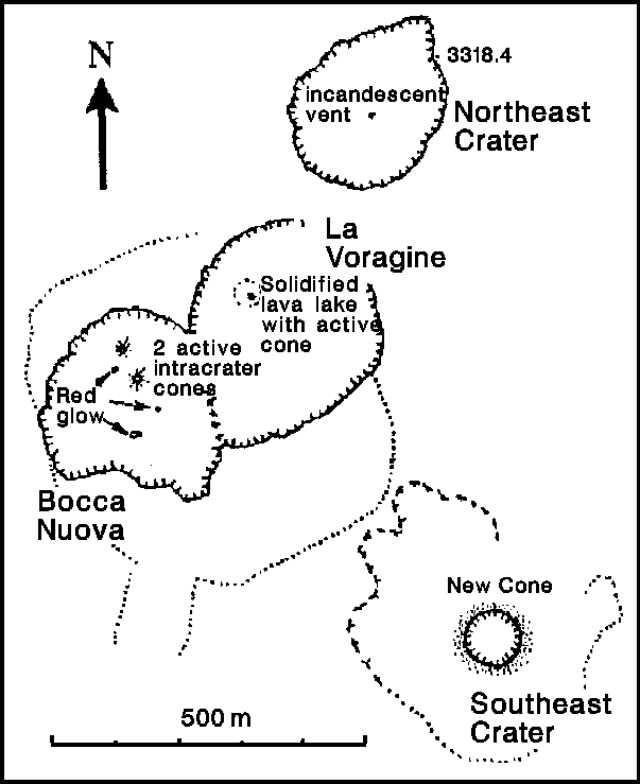Report on Etna (Italy) — July 1989
Scientific Event Alert Network Bulletin, vol. 14, no. 7 (July 1989)
Managing Editor: Lindsay McClelland.
Etna (Italy) Summit Strombolian activity; little deformation in past year
Please cite this report as:
Global Volcanism Program, 1989. Report on Etna (Italy) (McClelland, L., ed.). Scientific Event Alert Network Bulletin, 14:7. Smithsonian Institution. https://doi.org/10.5479/si.GVP.SEAN198907-211060
Etna
Italy
37.748°N, 14.999°E; summit elev. 3357 m
All times are local (unless otherwise noted)
Geologists observed Strombolian activity at three summit area craters (Bocca Nuova, La Voragine, and Southeast Crater; figure 28) and an incandescent gas vent in Northeast Crater during field work 26 May-1 July. Fresh-looking tephra was abundant W and SW of the summit craters, to 800 m from Bocca Nuova.
 |
Figure 28. Sketch map of Etna's summit region, showing features active during field work 26 May-1 July 1989. Courtesy of C. Oppenheimer and J. Murray. |
Bocca Nuova. Vigorous Strombolian activity from two vents on the crater floor, both building cones, was observed 29-30 May, 5, 18, 19, and 30 June, and 1 July. Small explosions and gas bursts averaged ~70/minute. Larger explosions ejected incandescent cowdung bombs, some of which fell 100 m beyond the crater rim. Crater depth was estimated at > 120 m. On 5 June, another glowing vent was visible on or near the flank of the largest active cone. Toward the S end of the crater floor, there was an irregularly shaped area of glowing lava, possibly a ponded flow or passive lava lake. Lava in one of the intracrater vents had a maximum brightness temperature of 1,019°C when measured with a 0.8-1.1 mm infrared thermometer. On 30 June, heat from one of Bocca Nuova's active vents was felt from the observation point on the NW rim.
La Voragine. Strombolian activity occurred from crater floor vents. Loud detonations were heard from the crater rim on 29 May; 17 were counted in 2 minutes. Ejecta were heard falling on the crater floor. During observations the evening of 5 June, four vents were visible, two of which were active. The largest of the 72 explosions counted in a 2-minute period sent bombs to 30 m above the rim. On 1 July, juvenile bombs were ejected by a glowing hornito or small cone on an apparent solidified lava lake. The 0.8-1.1 mm thermometer recorded a peak temperature of 821°C.
Southeast Crater. Strombolian eruptions continued from Southeast Crater's new cone 29 May-30 June, frequently ejecting incandescent tephra above the crater rim. On 4 June, bombs rose to 100 m above the cone. During a 10-minute period around noon, geologists counted 28 eruptions that projected bombs higher than the rim.
Northeast Crater. On 8 June, a vent 2-3 m in diameter was degassing near the middle of the crater floor. A peak brightness temperature of 462°C was recorded by an 8-14 mm infrared thermometer pointed at the vent's inner wall from ~ 50 m distance. Geologists noted that this instrument probably significantly underestimated the gas temperature (see 1 July data). There was no sign of fresh tephra. On 12 June at about 0850, four white "smoke rings" rose slowly from Northeast Crater. On 1 July, glow from the vent was visible during observations in low light shortly after 0600. A 0.8-1.1 mm infrared thermometer yielded a maximum temperature of 644°C, compared to 491° with the 8-14 mm instrument. Eight gas puffs and two more vigorous exhalations were counted in 1 minute.
Geodetic measurements. Very little vertical deformation has occurred since September 1988 (14:01). Slight subsidence was measured E of the summit, with a maximum displacement of 3 cm near the 1987 fissure (relative to a reference station 2.5 km SSW of the summit). A 3.5-cm swelling was measured on the Northeast Rift. A trilateration network on the upper E flank was reoccupied for the first time since June 1988, revealing movements of as much as 4 cm to the NE at stations in the Valle del Leone. The station on Monte Simone (4 km E of the summit) showed an anomalous displacement of 2 cm to the S since September 1987. Stations at Punta Lucia (1.5 km NNW of the summit) and Belvedere (2 km SSE of the summit) were assumed to be stable. Etna's summit elevation was determined at 3,318.4 m, using the base station near Piccolo Rifugio (2,516 m altitude) as a datum. Seismicity was detected optically through the levelling instrument, as in 1988 (14:01). During the early June levelling traverse, 36 shocks were observed, all within 2.2 km of the summit. The largest amplitudes noted were 70 µrad (1.5 km NE of the summit), 111 µrad (near Southeast Crater), and 123 µrad (400 m from Bocca Nuova).
Geological Summary. Mount Etna, towering above Catania on the island of Sicily, has one of the world's longest documented records of volcanism, dating back to 1500 BCE. Historical lava flows of basaltic composition cover much of the surface of this massive volcano, whose edifice is the highest and most voluminous in Italy. The Mongibello stratovolcano, truncated by several small calderas, was constructed during the late Pleistocene and Holocene over an older shield volcano. The most prominent morphological feature of Etna is the Valle del Bove, a 5 x 10 km caldera open to the east. Two styles of eruptive activity typically occur, sometimes simultaneously. Persistent explosive eruptions, sometimes with minor lava emissions, take place from one or more summit craters. Flank vents, typically with higher effusion rates, are less frequently active and originate from fissures that open progressively downward from near the summit (usually accompanied by Strombolian eruptions at the upper end). Cinder cones are commonly constructed over the vents of lower-flank lava flows. Lava flows extend to the foot of the volcano on all sides and have reached the sea over a broad area on the SE flank.
Information Contacts: J. Murray and C. Oppenheimer, Open Univ; A. Jones, Univ of Lancaster; P. Cruddace, Univ of Newcastle; P. Aragno and S. Haefeli, SVG.

